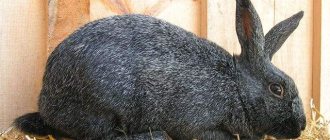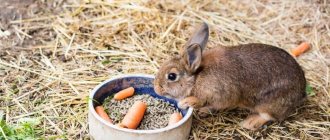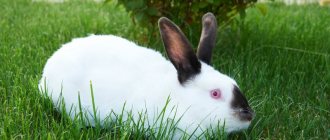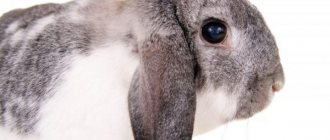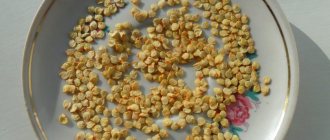The New Zealand Red rabbit has a strong build. Another distinctive feature is its miniature size and average weight. Adults should not exceed 5 kg. The pet's fur is brown. Rabbits of this breed are able to withstand different climatic conditions. This is why many breeders prefer to breed animals outside. The paws are covered with dense down, which protects from injury.
Description of the breed
The New Zealand red rabbit is a domestic species of small, short-haired animal. They are used to obtain dietary meat and luxurious fur. Individuals were first bred in the United States of America in early 1912. Large animals were presented at an animal exhibition, after which they became very popular among rabbit breeders around the world.
A healthy individual has a strong constitution. These rabbits are able to cope with different climatic conditions. They are unpretentious eaters and gain weight quickly.
Female rabbits are quite fertile. In one litter they are able to bear up to 9 rabbits. The fact is that with proper feeding, they produce a sufficient volume of milk to feed all the babies. The liquid contains a high level of useful macro- and microelements. The optimal percentage of milk fat content allows rabbits to quickly gain weight and develop in accordance with the requirements.
The shortened fur of an adult rabbit is valued for its decorative qualities. In addition, the hairs are stiff and thick. Fur products made from the skins of this breed are distinguished by their wear resistance.
In the wild, the color of the skin of such a rabbit had a characteristic yellowish tint, but the painstaking work of breeders made it possible to obtain animals with a reddish tint. According to scientific research, individuals from the wild and purebred rabbits from New Zealand were used in the work.
Pedigree individuals of the New Zealand red rabbit are distinguished by the following characteristics:
- Short and thick coat;
- The head section is pointed;
- Fleshy, spatulate-shaped ears;
- The eyeballs are dark brown;
- The body is like a cylinder with well-developed muscles;
- Wide and deep chest without a characteristic dewlap;
- Wide lumbosacral region;
- The front legs are shortened;
- The weight of a healthy individual reaches up to 5 kg;
- Body length is 52 cm;
- Males are 10 cm smaller than females.
Physical parameters
New Zealand rabbits are quite large in size. Their body is shaped like a torpedo. It is about 50 cm in length. The weight of animals of this breed is in the range of 4.5-5.5 kg. The muscles are well developed. The strong bones have a powerful sacrum. The back is fleshy and the hind legs are large and strong. This allows them to be successfully used in meat production.
The body of the animal is covered with thick, hard fur up to 4 cm long. On the ears, up to 12 cm long, the fur is sparse. A wide and strong head sits on a short but powerful neck. The eyes are large and almond-shaped. The mustache bristles in different directions. The color has three main varieties - red, white and, somewhat less commonly, black.
Female New Zealand rabbits have high fertility. The litter consists of 8-10 newborns.
Rabbits of the New Zealand breed have a beautiful appearance, as well as good physical characteristics. Due to their attractiveness, friendly and calm nature, they are often used as pets. At the same time, such qualities as lack of aggressiveness in behavior, responsiveness to affection, and ability to play with small children are also valued.
The New Zealand rabbit gains weight quickly. At the age of three months he already weighs about 2-3 kg.
How to choose a purebred rabbit
Basic rules when choosing a rabbit:
- Experienced rabbit breeders recommend purchasing rabbits of this breed at the age of 3 months. After purchase, it is not recommended to change your diet so as not to provoke serious illnesses. Well-developed individuals look well-fed and quite mobile.
- When choosing, it is necessary to evaluate behavior among other animals. If rabbits sit in the corner and do not react to extraneous stimuli, then such phenomena indicate illness.
- The rabbit's nose should be dry and free of any discharge. If crusts and abrasions are present on the surface, this indicates a fungal infection or pathological changes.
- The skin of the New Zealand Red rabbit should be soft to the touch and have a glossy sheen. As for the reproductive organs, in healthy rodents they are well developed. There should be no rash, irritation or scratches on the surface.
- If there is matted hair on the inside of the front paws, this sign indicates the presence of a contagious runny nose. During the process of cleaning the nasal passage, the rabbit removes up to 50% of the mucus using its limbs.
It is recommended to buy a healthy individual from special rabbit breeding farms. Professionals in these centers regularly monitor the condition of the animals and provide them with timely assistance.
What do rabbits get sick with?
New Zealand rabbits are susceptible to many diseases, like their long-eared relatives.
Diseases that most often affect New Zealand breed rabbits:
1. Myxomatosis. Treatment: Antibiotics. Prevention: Vaccination.
The edematous form of myxomatosis is characterized by: lethargy, refusal to eat; · increased body temperature over 41C; · swelling and inflammation of the eyelids; · discharge of pus from the nose and eyes; · the appearance of edema – “dropsy” on the genitals and head”; · blue mucous membranes; · rapid weight loss; · blindness; · appearance of folds on the neck. The edematous form of the disease is fatal in 100% of cases. Characteristics of the nodular form of myxomatosis: · appearance of nodules on the body; · partial fusion of nodular lesions; · appearance of necrotic areas (in the absence of treatment). The nodular form of the disease is cured in 50% of cases.
2. Viral hemorrhagic disease. Treatment: There are no medications that can destroy the causative agent of this disease. Serum partially helps, but only if it is administered within the first 2 hours after infection. Prevention: Vaccination.
The disease is fleeting. After infection, convulsions, refusal to eat, apathy, and lethargy are observed. Rabbits have miscarriages. Sometimes bruising from the nose, eyes, blepharitis, diarrhea, and tachycardia appear. Considering that death occurs within 30-32 hours, it is difficult to differentiate the diagnosis. Before death, the body temperature rises to 42C, and the long-eared animals begin to moan and squeak.
3. Coccidiosis. Treatment: Coccidiostatics (Solicox, Baycox, Brovitacoccid), antibiotics, probiotics. Prevention: Regular disinfection.
Symptoms of the icteric form: · rabbits become apathetic, lethargic; · the animal drinks a lot; · no appetite; · jaundice and exhaustion are noted; · the stomach is very bloated; · the animal begins to hump due to pain. Signs of the intestinal form: · lack of appetite; · a lot of mucus streaked with blood appears in the stool; · green diarrhea changes to bloody over time; · mucous membranes become noticeably pale; · the stomach is bloated; · the coat becomes dull; · dehydration.
4. Infectious rhinitis. Treatment: Immunomodulators (ribotan, derinat), anti-inflammatory drugs, and in severe cases - antibiotics. Prevention : Maintaining temperature; control over the absence of drafts, a balanced diet, routine disinfection.
Signs of the disease: · frequent sneezing; · discharge of mucus and pus from the nose; · redness of the nasal mucosa; · The rabbit constantly scratches its face with its paws.
5. Infectious stomatitis. Treatment: Rinsing the mouth with a solution of potassium permanganate, irrigating the mouth with antibacterial solutions. Prevention: Hygienic care, constant disinfection, overcrowding of eared animals is not allowed.
Symptoms: · hypersalivation; · plaque on the mucous membranes of the mouth and tongue; · the coat of the head and chest is wet; lethargy; · loss of appetite; · weight loss; · disturbances in intestinal function.
How to keep rabbits
New Zealand red rabbits are unpretentious to their living conditions. In the summer, outdoor enclosures are made for them. Using a special cage, they are planted on the grass. However, in the process of arranging the enclosure, it is necessary to fence it with a net and ensure that rodents do not dig under it. Rabbit breeders recommend regularly walking young rabbits.
Important! In winter, rabbits can be kept in special multi-tiered cages. Individuals of different sexes should be in different cages.
Basic rules for keeping rabbits:
- The main requirement is the design of the ventilation system. To equip closed spaces, it is recommended to purchase hoods. They allow you to quickly clean the air and prevent the growth of fungal mold indoors.
- To prevent animals' paws from suffering from the appearance of corns and tangles, it is recommended to replace the mesh floor with a wooden covering. For this purpose, pine, hazel, and maple wood is used.
- In some cases, rabbits may chew on wood to wear down their teeth. For these purposes, it is recommended to install birch, maple or alder sticks in one of the corners of the cage. The surface of these elements is pre-cleaned with antiseptic preparations.
- For animals to rest, it is necessary to provide special shelves. These elements will help prevent the appearance of bald spots on the coat, and will also help prevent hypothermia in the rodent’s body.
Where does the New Zealand breed come from?
To create these rabbits through selective breeding, biologists worked hard for about 100 years. Let us note that scientists are now continuing to work in this direction and are breeding New Zealanders, trying to improve their characteristics.
They first learned about New Zealand rabbits at the beginning of the 20th century. In California, a local farmer decided to produce a new breed by combining the Flemish giant and the Belgian hare. In this way it was possible to breed the New Zealand one.
Initially, the offspring of the crossed individuals were red. However, later, when improvements continued, it became possible to breed white individuals. In particular, in order to breed a white animal, it was necessary to carry out interbreeding (Angora, red individuals, American white and Flemish giant).
Many years later, scientists obtained a black specimen, as well as mixed varieties. The researchers were able to achieve the desired result, since they had to cross species for a long time, compare them, and determine characteristic features.
Maintenance of pregnant females
For pregnant females, it is recommended to build a separate cage structure. It should have a nest that helps hide the offspring from prying eyes.
Some rabbit breeders prefer to build a small house to further house the rabbit. If it is not possible to make such a structure, then the way out of the situation would be to use a large amount of soft hay. It is not recommended to place thorny types of dry plants in a cage. They can injure the delicate skin of rabbits. To make the nest seem cozy and soft, the female uses her own down, with which she covers the entire space.
Pregnant rabbits should be placed in a different room to reduce stressful situations. Particular attention must be paid to their diet. Food for individuals should be high in calories. The rabbit's menu may include grain and cereal mixtures, large volumes of juicy greens, and, in winter, hay.
What does it take to start breeding a breed?
To start breeding New Zealand rabbits, large financial expenditures are not required. It is enough to choose the right rabbit, provide a place for the animal to live comfortably and stock up on the necessary amount of food. All investments pay off literally after the birth of the first rabbits.
Feed
Most of the animals' diet should consist of fresh grass, which is why feeding in the summer will not be a major expense. It is most profitable to breed rabbits outside the city, since within the city every day it turns out to be problematic to find the required amount of greenery. Especially if the farmer has a large number of individuals.
When collecting grass, the environmental component is important - urban grass cannot be considered an environmentally friendly product. Such nutrition can cause great harm to the rabbit's health.
To feed 20 rabbits you need about 1 bag of fresh grass every day. Greens are added to the cage as the rabbits eat it, but do not give too much grass. Such actions will lead to severe contamination of the cell. In addition, animals simply will not eat dirty or not fresh grass, which can cause them to remain hungry.
Read the article about how and what to feed rabbits.
Do not forget about the grain component of the diet. Compound feed is suitable for this, which can be purchased at the poultry market. The cost of one bag is about 500 rubles. Depending on the overall diet, it is determined how much food will be enough. It is best to use additional complementary foods, and then 1 bag of compound feed will be enough to feed 20 rabbits for about 14 days.
Place of detention
A specialized store sells ready-made enclosures or cages, but you can also make them yourself, if possible. It is better to opt for professional cages, which come in a variety of designs. There are also multi-level cells with varying degrees of complexity.
Subject to the purchase of a finished product, in order to equip a future rabbit farm, you need to immediately make a large investment. The average cost of one finished cell is approximately 10,000 rubles. There can be no more than 4 adults in one cage.
If it is not possible to make large financial investments, you can start making cells yourself. Such designs will be simple, but durable and easy to implement. You can use plywood, natural wood, metal mesh and simple boards.
The ideal option would be to make the simplest and most functional cells. Be sure to consider the following points:
- use only a strong mesh so that animals cannot gnaw it;
- there must be room inside the cage for free movement of animals;
- consider good ventilation, as stale and stagnant air leads to the rapid development and spread of bacteria, which ultimately leads to a global epidemic;
- if you equip a mesh floor and the cage is in a suspended position, this will greatly facilitate the cleaning process and will not allow waste to accumulate;
- feeders and drinkers should always be freely accessible.
In enclosures where females and offspring are kept, there should also be individual houses. In such houses, the female rabbits themselves arrange the nest necessary for the comfortable living of the young.
When designing a cage, take into account certain characteristics of these animals:
- the male must have a separate cage, since rabbits can fight among themselves, so you should not constantly keep him together with the female;
- several individuals can be placed in one cage, but these must be young rabbits of the same age;
- Before giving birth, the female rabbit moves to a separate housing, since the young offspring may be trampled or killed by other animals.
Number of rabbits
At the initial stage, one of the most important points is the number of animals. To find out how profitable and promising the project will be, you will need to be patient. You should not immediately buy a herd, since only 2-3 females and one male will be enough. Such a number of animals will help you understand whether it is worth pursuing the business further, and will also allow you to acquire the necessary skills in caring for rabbits.
A small farm does not require any large financial investments or time expenditure. However, subject to a competent approach, full return will occur in the very near future. The reproduction rate of rabbits is high, so within a month you can get a full-fledged herd, which will bring a good income.
Selecting a suitable individual
Choose a young and healthy female with a male for breeding. To be confident in the breed, give preference to trusted breeders.
Diet
Products in a rabbit's diet must be of high quality. The animal's menu must be complete. For this, fresh vegetables and fruits, grain mixtures, hay and juicy grass are used.
Root vegetables and fruits are pre-cleaned in warm water. The only drawback of this breed is its tendency to gastrointestinal diseases. Thorough cleaning of food helps keep your pet healthy.
Important! In summer they stock up on fragrant hay. For this purpose, meadow grass species are chosen. After mowing, they are turned regularly to ensure even drying. The finished product should be stored in closed areas with good ventilation.
Particular attention should be paid to regular drinking. To do this, use fresh water, to which vitamins and medicines can be added to prevent seasonal diseases.
Mr. Tail Explains: Cost and Choice
This breed is so easy to care for that it is suitable for beginner rabbit breeders.
The optimal age for choosing pets is 3-4 months; the animals are already vaccinated and resistant to stress caused by transportation to a new place of residence.
It is advisable to purchase young stock for rabbit fattening from large farms, and a breeding pair from large nurseries and experienced farmers.
The cost of young animals is 250-650 rubles per kg of live weight, depending on the species. The most expensive are white New Zealand rabbits.
A breeding specimen costs from 1,200 to 5,000 rubles.
When choosing a rabbit for breeding, you should pay attention to the correct bite, straight back and paws, and high mobility of the animal.
The rabbit should not have swollen and watery eyes, a runny nose, dirty genitals, or dull fur.
Rules of care
An important requirement for keeping the New Zealand breed is the absence of external stimuli. Rabbits cannot tolerate frequent loud sounds, too bright light and regular mechanical stress. Failure to comply with these requirements provokes the onset of deep depression and illness.
Caring for rodent fur is quite simple. To do this, just buy a rubber brush and brush it regularly. You can remove tangles with a special device. Dirty areas must be washed and dried thoroughly. After bathing, it is forbidden to place the animal in a room with a low temperature.
The New Zealand Red rabbit is considered early maturing. Males are ready to have sexual intercourse at the age of 8 months. However, females are not ready to bear offspring. That is why they must be located in different cells.
Regular examination by a professional veterinarian helps prevent serious pathological changes in the body. Particular attention must be paid to the frequency of vaccinations.
At first glance, animals of this breed may seem unpretentious, but seasonal changes can provoke serious diseases, due to which the animal can suffer seriously.
Breeding conditions
To keep pets and care for them, as already noted, it does not require a lot of effort, time and financial costs. Rabbits of the New Zealand breed get sick infrequently and produce large and high-quality offspring. After slaughtering the animals, the breeder receives a lot of meat product, which he can keep for his own purposes or sell.
The New Zealander, including the red variety, does not respond to temperature changes. His body copes with both hot and very cold weather conditions. As for life expectancy, it can be 5–10 years. This indicator characterizes red and white rabbits.
White rabbits are similar in breeding method to other representatives of this breed, even though the New Zealand white rabbit is much more popular than others.
A female rabbit can become pregnant regardless of the time period, be it summer or winter. She expects offspring for a month. After giving birth, 3 days may pass and the female will be ready to mate again.
When there is little time left until childbirth, it is necessary to equip a nest where the female will feed her cubs. For preparation you will need dry grass, insulation, and fur. Newborns have no hair and cannot hear or see anything.
As soon as the babies are 5–6 days old, the skin begins to become covered with fur. After another 5 days, the sense organs develop. Initially, baby rabbits feed exclusively on mother's milk, which contains all the necessary vitamins and nutrients.
After their age has reached the 3-week mark, the babies are separated from the female. Their diet changes completely: instead of mother's milk, they begin to eat hay and feed mixtures.
A female rabbit can give birth to a maximum of ten babies at one time. When they reach 3 months of age, their weight is 2 kg or more. Once the age is 5 months, the rabbit becomes an adult and is ready to mate to produce offspring. Note that it is important for these animals to regularly produce offspring.
Raising rabbits
Young offspring require proper care:
- Regular and balanced nutrition. For this purpose, ground cereals of wheat, millet and barley are used. During the feeding period, it is necessary to provide fresh drink with vitamin compositions in the autumn-winter period. At this time, rabbits experience a severe deficiency of useful components;
- Visual inspection. Young offspring often develop serious health problems. They are considered dangerous to other rabbits and can cause mass mortality. It is recommended to isolate baby rabbits in a separate box for further treatment;
- Get vaccinated. Beginners are advised to seek the help of a highly qualified veterinarian. He will help you draw up a vaccination plan and select the right drugs in accordance with general requirements. A preliminary analysis of the general condition of the individuals is carried out;
- It is important to keep cages and premises clean. General cleaning should be carried out 2 times a week using disinfectants.
Advantages and disadvantages of New Zealand rabbits
This breed has deservedly taken one of the leading places in the meat and down breeds. The advantages of breeding New Zealanders are:
- excellent early maturity;
- calm, not fearful character;
- high profitability of production due to the sale of meat and skins;
- not the most difficult care;
- resistance to diseases;
- unpretentiousness of rabbits and non-selectivity in nutrition.
The disadvantages of the breed are few:
- tendency to overeating and obesity;
- poor tolerance to high temperatures.
What vaccinations do rabbits need to get?
At the age of 30 days, the rabbit is given the first vaccination against myxomatosis. The dosage of the drug should be selected by an experienced veterinarian. The specialist takes into account the animal’s age group, its weight and appearance at the time of the procedure. Rodents whose condition seems unsatisfactory are prohibited from undergoing any intervention.
At the age of 50 days, a vaccine against viral hemorrhagic disease is given. The drug is re-administered after 3 months, and then the interval is increased to 6 months from the date of the last intervention.
It is recommended to purchase the vaccine for injection at veterinary pharmacies. Beginning rabbit breeders should first consult with specialists. In addition to the vaccine ampoules, detailed instructions are provided describing the recommended dosage and frequency of administration of the drug.
Which breed is best to crossbreed with?
In practice, you often have to choose which rabbits to combine for mating.
In rabbit breeding, purebred matings are carried out to enhance the best qualities of the breed. It is not recommended that the partners being crossed are related. This can lead to a decrease in the quality of the offspring and problems in bearing them. If something needs to be changed, then methods of crossing different breeds are used.
To increase the weight and fertility of rabbits, meat breeds are crossed with those most similar to them. The most successful results are shown by the following variants of crossing individuals:
- gray giant - New Zealand white;
- Californian breed - New Zealand white;
- Soviet chinchilla - New Zealand;
- New Zealand - white giant;
- New Zealand - Soviet chinchilla;
- New Zealand - Vienna blue.





